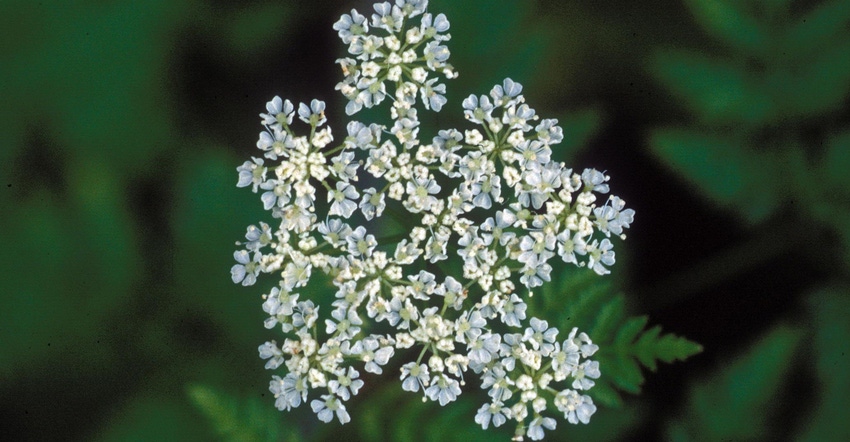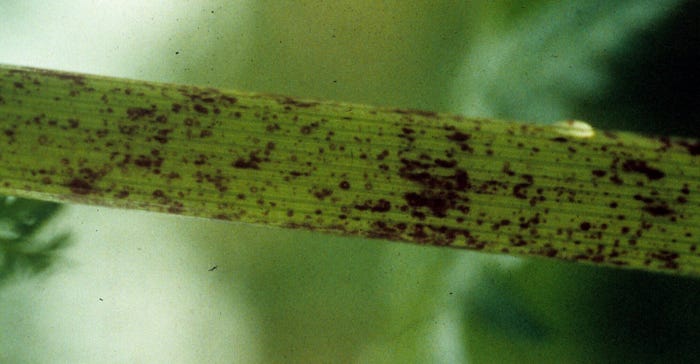Don’t mow or spray during the grazing season; it could make poison hemlock tastier to cattle.

Looks can be deceiving. Those white spring flowers that dot many Midwest pastures are toxic to humans and animals. Your first instinct may be to kill the weed by spraying pastures, but one university Extension specialist warns against it.
Poison hemlock is one of the first weeds to green up in spring, and it grows up to 6 feet tall. The first year of growth, poison hemlock looks much like a rosette. It is low to the ground, a small bush-like plant. The second year, it is bolting and flowering.
The flowers look similar to wild carrots, but are generally smaller. They are a flat-top flower made up of a lot of different smaller flowers. Still, at the flowering stage, it is easier to tell the difference because the purple stem is very visible.
Poison hemlock in pastures is toxic to animals. However, if you see it and are grazing, spraying could cause more harm than good.
Concern for cattle
The alkaloids in poison hemlock are particularly toxic to cattle and horses, even in small amounts, says Tim Evans, toxicology section head at the University of Missouri’s Veterinary Medical Diagnostic Laboratory.
In relatively small doses, the alkaloids can affect the nervous system like nicotine, with clinical signs including dilation of the pupils, increased or reduced heart rate, coma, trembling, nervousness and respiratory paralysis, suffocation and death.
Evans says farmers should move animals from infected pastures and contact a veterinarian immediately if animals show signs of poisoning. Death can occur quickly, he adds.

PURPLE PROBLEM: The one difference between wild carrot and poison hemlock is the purple coloring on the stem or stalk.
Cattle, sheep, goats and pigs that eat this plant during the first trimester of pregnancy may give birth to offspring with limb deformities, a condition known as crooked calf syndrome in cattle and more generally as multiple congenital contractures.
Immature poison hemlock leaves seem to be most palatable to unsuspecting livestock. Animals usually avoid mature plants, especially when offered other palatable feedstuffs. University of Nebraska Extension crop Extension educator Melissa Bartels warns farmers not to control hemlock during the grazing season by mowing or spraying with 2,4-D plus dicamba.
“This alters the plant and can actually increase its palatability, making it more likely animals will eat enough of it to cause poisoning,” she says. “Instead, control poison hemlock in the early spring or fall when animals are not in the pasture, or fence off large patches from livestock if control is necessary.”
Evans notes that poison hemlock is toxic, whether livestock graze it in the pasture or farmers bale it and feed it later. Farmers can also manually remove poison hemlock with a shovel.
Problem for crops
According to University of Missouri Extension weed scientist Kevin Bradley, poison hemlock, once found primarily in pastures and fence rows and along roadsides, now appears as a weed in no-till cropping systems. It is a biennial, taking two years to grow and germinate seeds, but it can produce up to 38,000 seeds per plant.
Nonchemical control options include weeding, mowing and tillage, Bradley says. In crops, growth regulator herbicides and products that contain 2,4-D, dicamba or 2,4-D plus triclopyr are options.
Bradley says research at Purdue University showed that dicamba plus glyphosate may offer more consistency and control than applications of glyphosate and 2,4-D.
The key to control is applying the herbicide when plants are young and still in the rosette stage, he says. Mature plants do not respond to chemical control measures.
Safety for humans
When dealing with poison hemlock, wear protective gear including gloves, long sleeves, pants and eye protection. Sap from poison hemlock touching the skin can cause blisters and welts, according to USDA. There is no known treatment.
University of Missouri Extension and University of Nebraska Extension contributed to this article.
About the Author(s)
You May Also Like



.png?width=300&auto=webp&quality=80&disable=upscale)
.png?width=300&auto=webp&quality=80&disable=upscale)
